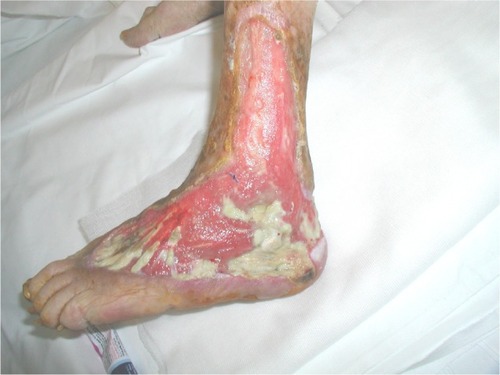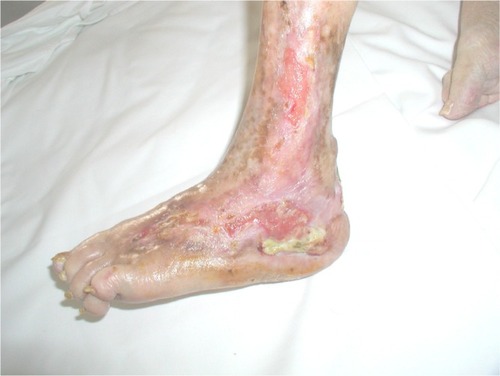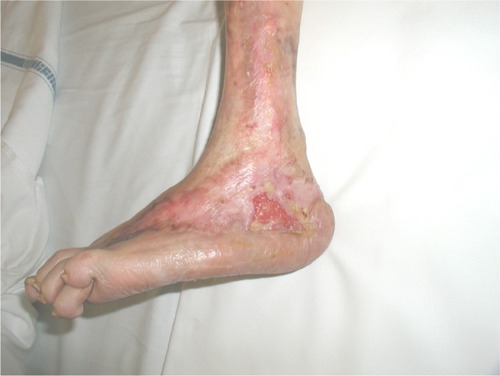Abstract
Skin ulcers are a common issue in the elderly, as physiological loss of skin elasticity, alterations in microcirculation, and concomitant chronic diseases typically occur in advanced age, thereby predisposing to these painful lesions. Wound-related pain is often associated with skin ulcers and negatively impacts both the patient’s quality of life and, indirectly, wound healing. Pain management is an ongoing issue in the elderly, and remains underestimated and under-treated in this fragile population. Recent guidelines suggest the use of opioids as the frontline treatment of moderate and severe pain in nononcological pain in the elderly. However, due to the concerns of adverse reactions, drug interactions, and addiction, clinicians frequently hesitate to prescribe opioids. This case report describes an elderly diabetic patient with multiple ulcers of the lower limbs suffering wound-related pain. In our report, oxycodone/naloxone has proved to be an effective and safe drug, providing pain relief as well as increased compliance when redressing wounds and faster healing compared to that in similar patients. Our case provides anecdotal evidence, supported by other studies, to justify future, larger studies on chronic pain using this therapy.
Introduction
Skin ulcers are secondary lesions characterized by chronic damage to the dermis, and subsequently the underlying fascia, with little or no tendency to spontaneous healing. Skin ulcers may represent the clinical manifestation of the interaction between numerous systemic and local factors, with various pathophysiological mechanisms present contemporarily. With increased age, the prevalence of chronic skin ulcers tends to increase, involving especially the geriatric population. Several pathophysiological mechanisms related to aging underlie this phenomenon, such as the physiological loss of trophic dermo-epidermal elasticity and concomitant alterations in skin microcirculation in addition to the frequent presence of comorbidities that could adversely affect the development of skin ulcers.Citation1
Pain associated with chronic skin ulcers is a very significant factor that should be highlighted. Negative outcomes in terms of quality of life and wound healing are associated with diminished cooperation of the patient during wound redressing. Wound pain can be explained by a variety of mechanisms: inflammatory processes increasing the sensitivity of pain receptors, tissue damage causing stimulation of pain receptors, damage to terminal end of the axon and/or presynaptic terminal, and possibly local infections aggravating sensory nerves.Citation2 Therefore, pain management represents an essential side of wound healing as a satisfactory analgesic control is undoubtedly the first step on the path of healing itself.
Chronic skin ulcers, particularly those affecting the lower limbs, are major complications in diabetes and often lead to radical surgery.Citation3 Type 2 diabetes mellitus is one of the main causes of chronic ulcers in the elderly. The treatment of diabetic ulcers in this fragile population is a major challenge due to a significant reduction in the skin’s regenerative capacity. These negative factors are exacerbated by several critical issues in frail geriatric patients such as multiple comorbidities (eg, arterial insufficiency, neuropathy, and diabetic skin microangiopathy), increased risk of infection, polypharmacotherapy, cognitive impairment, and poor compliance to dressing procedures.Citation4,Citation5
Despite the high prevalence of chronic pain in the elderly,Citation6 major barriers to the effective identification and management of pain in the older population have been identified.Citation7 As a matter of fact, pain is often underestimated and undertreated among elderly people.Citation8 A recent study on 29 patients with scleroderma has proved oxycodone to be an effective and safe treatment of pain caused by severe scleroderma skin ulcers; in addition, it markedly improved the patient’s compliance to local wound care procedures.Citation9
Opioids are the established treatment for moderate and severe chronic oncological pain, as recommended by the World Health Organization (WHO);Citation10 furthermore, recent guidelines suggest opioids as the mainstay of treatment for chronic nononcological pain even in elderly patients.Citation11,Citation12
One of the main limitations to the use of opioids in the elderly is the fear of adverse gastrointestinal events (straining, incomplete evacuation, bloating, abdominal distension, and gastric reflux) due to the binding of opioids to receptors in the gastrointestinal tract. This is known to cause a condition known as opioid-induced constipation (OIC),Citation13 which is potentially even more harmful in elderly patients. Oral naloxone, due to its very low systemic bio-availability, predominantly antagonizes opioid receptors in the gastrointestinal tract and is effective in the prevention of OIC.Citation14–Citation17 Oral prolonged-release oxycodone/naloxone combination (OXN-PR) has also been shown to be equally effective compared to oxycodone alone in patients with moderate-to-severe nonmalignant pain.Citation18–Citation21 OXN-PR has been shown to be effective and safe in the treatment of neuropathic pain also.Citation22
Recent studies have shown oxycodone/naloxone association to be safe and effective in the elderly.Citation23–Citation25 To our knowledge, there are no significant systematic data on the use of this combination in the treatment of pain associated with skin ulcers in the elderly.
Here, we describe the case of an elderly diabetic patient suffering from years of multiple chronic ulcers of the lower limbs associated with significant chronic pain, in which the combination of oxycodone/naloxone has provided satisfactory analgesic control, and subsequently, complete healing and (long-term) pain relief.
Written informed consent was obtained from the patient for the publication of this case report and accompanying images. Ethics approval is not needed for the present case report, as it involves current clinical practices.
Case report
The patient, CA, an 82-year-old female, suffering from type II diabetes mellitus for over 20 years complicated by peripheral neuropathy and arteriopathy, came to our attention presenting painful skin ulcers of the lower extremities (, day 0 on admission). She was under basal–bolus scheme insulin, and on admission, glycemic values were somewhat uncontrolled (HbA1c 55 mmol/mol, fasting glucose 180 mg/dL). Despite the ongoing analgesic treatment (acetaminophen 3,000 mg daily), pain control was poor and wound treatment was strongly limited by the intense pain. She had also been prescribed tramadol by her general practitioner, stopped early due to nausea and vomiting. On admission, OXN-PR 5/2.5 mg bid (twice a day) was started, and acetaminophen was stopped.
In order to evaluate the effectiveness and tolerability of the OXN-PR association, the following parameters were assessed during the time of observation: pain intensity (on a verbally administered 0–10-point Numeric Rating Scale [NRS], expressed as the mean of assessments at rest, on movement, daytime, and nocturnal of the last 24 hours), and the impact of pain on daily activities according to the Brief Pain Inventory (BPI) of both severity and interference domains, cognitive function using the Mini Mental State Examination (MMSE), and functional autonomy through the Barthel Index score. Bowel function was evaluated using the Bowel Function Index (BFI, a validated reproducible measure that detects clinically meaningful changes in constipation, with scores ranging from 0, free from symptoms, to 100, most severe symptoms; normal bowel function is defined as a BFI value of ≤29). Common opioid-related adverse events (nausea, vomiting, dizziness, drowsiness, dry mouth, and itching) were also monitored.
At baseline, pain was severe and had a markedly negative impact on daily activities. Functional autonomy was moderately impaired, with preserved cognitive status and bowel function ().
Table 1 Clinical findings on admission and throughout the observation
Subsequent pain assessment showed a clear reduction in the NRS score, which progressively decreased to 5 after 1 week in the absence of opioid-related adverse events. The dose of OXN-PR was increased to 10/5 mg bid. Residual pain was reported especially in the early hours of the morning and during ulcer dressing procedures. The evaluation after 2 weeks and 4 weeks showed a further reduction in NRS score, which decreased to 2 points during both assessments.
In concomitance with the striking subjective improvement, the lady became more compliant to dressing procedures, significantly contributing to the complete healing of the ulcers in the following 4 weeks ( and ). Throughout this period, no minor or major adverse effects were observed. No significant changes were also found regarding cognitive status and bowel function; at final functional assessment, optimal analgesic control was associated with a marked functional improvement ().
Discussion
In caring for this patient, the association of OXN-PR demonstrated high efficacy and tolerability in the treatment of pain caused by diabetic lower limb ulcers. At the same time, an increase in the patient’s compliance to ulcer dressing procedures was noted.
In total, 20/10 mg daily dose of OXN-PR proved sufficient in obtaining a more than satisfactory analgesic efficacy. No adverse effects were observed, consistent with the previously reported tolerability of this oral opioid agonist–antagonist combination in the elderly.Citation16,Citation18,Citation19,Citation26 In particular, no changes were observed in the BFI score, confirming the previously reported excellent gastrointestinal tolerability of this drug combination, which is certainly of extreme importance in the geriatric population.Citation27,Citation28 Besides its effectiveness, the additional benefit of OXN-PR is to prevent OIC obviating the need of laxatives in the majority of patients. Avoiding OIC represents a major issue in older and fragile patients.
Topical analgesic applications for ulcerations are available; on the other hand, topical analgesics are not so widely used, and data from clinical trials are limited. In our patient, skin ulcers were too large for a topical analgesic treatment.
This case report emphasizes three main issues in pain management in the elderly: 1) switching opioids (in our case, from tramadol to OXN-PR) is a reasonable approach, and it is always worth considering while managing pain, as current guidelines on pain management for geriatrics suggest;Citation11,Citation12 2) slowly titrating opioids is required in order to avoid adverse events; prescribing opioids to this fragile population should always follow the rule “Start slowly, go slowly”;Citation11,Citation12 and 3) OXN-PR, according to its peculiar pharmacological profile, should be considered as a potentially safe tool for managing pain, preventing OIC in older patients.Citation27,Citation28
In the literature, the OXN-PR combination has previously been demonstrated to be effective in controlling both neuropathic and nociceptive pain.Citation18,Citation22 As wound-related pain is typically both neuropathic and nociceptive, the OXN-PR combination could be reasonably considered a potentially ideal solution to a very complex and common problem: chronic pain due to skin ulcers in geriatric comorbid patients.
OXN-PR combination has been recently found effective and safe in the treatment of chronic nononcological pain in the elderly with a good efficacy profile and a low incidence of adverse effects.Citation22–Citation25
Considering all the current evidence, as well as our experience, we strongly endorse further clinical studies on larger cohorts of geriatric patients, to formally evaluate the effectiveness of this drug combination in the management of skin ulcer-related pain in the elderly.
Author contributions
All authors contributed toward data analysis, drafting and critically revising the paper and agree to be accountable for all aspects of the work.
Acknowledgments
Written informed consent was obtained from the patient for publication of this case report and accompanying images.
Disclosure
The study was completed independently with no funding. The authors report no conflicts of interest in this work.
References
- BriggsMClossSJPatients’ perceptions of the impact of treatments and products on their experience of leg ulcer painJ Wound Care20061533333717001939
- FleckCAManaging wound pain: today and in the futureAdv Skin Wound Care200720313814517473719
- CeveraJJBoltonLLKersteinMDOptions for diabetic patients with chronic heel ulcersJ Diabetes Complications1997113583669365879
- FalangaVWound healing and its impairment in the diabetic footLancet20053661736174316291068
- FrankCApproach to skin ulcers in older patientsCan Fam Physician2004501653165915648380
- BerghISteenGWaernMPain and its relation to cognitive function and depressive symptoms: a Swedish population study of 70-year-old men and womenJ Pain Symptom Manage20032690391214527759
- AllcockNMcGarryCManagement of pain in older people within the nursing home: a preliminary studyHealth Soc Care Comm200210464471
- BernabeiRGambassiGLapaneKManagement of pain in elderly patients with cancerJAMA1998279187718829634258
- GiuggioliDManfrediAColaciMFerriCOxycodone in the long-term treatment of chronic pain related to scleroderma skin ulcersPain Med201010101500150320456083
- VentafriddaVSaitaLRipamontiCDe ConnoFWHO guidelines for the use of analgesics in cancer painInt J Tissue React1985793962409039
- American Geriatric SocietyPharmacological management of persistent pain in older personsJ Am Geriatr Soc2009571331134619573219
- British Geriatric SocietyGuidance on the management of pain in older peopleAge Ageing2013421i1i5723420266
- KurzASesslerDIOpioid-induced bowel dysfunction: pathophysiology and potential new therapiesDrugs20036364967112656645
- Mueller-LissnerSFixed combination of oxycodone with naloxone: a new way to prevent and treat opioid-induced constipationAdv Ther20102758159020714946
- LöwensteinOLeyendeckerPHoppMCombined prolonged-release oxycodone and naloxone improves bowel function in patients receiving opioids for moderate-to-severe non-malignant chronic pain: a randomised controlled trialExpert Opin Pharmacother200910453154319243306
- MeissnerWLeyendeckerPMueller-LissnerSA randomised controlled trial with prolonged-release oral oxycodone and naloxone to prevent and reverse opioid-induced constipationEur J Pain200913566418762438
- BurnessCBKeatingGMOxycodone/naloxone prolonged-release: a review of its use in the management of chronic pain while counteracting opioid-induced constipationDrugs201474335337524452879
- VondrackovaDLeyendeckerPMeissnerWAnalgesic efficacy and safety of oxycodone in combination with naloxone as prolonged release tablets in patients with moderate to severe chronic painJ Pain200891144115418708300
- DavisMGoforthHWGamierPOxycodone combined with opioid receptor antagonists: efficacy and safetyExpert Opin Drug Saf201312338940223534906
- LöwensteinOLeyendeckerPLuxEAEfficacy and safety of combined prolonged-release oxycodone and naloxone in the management of moderate/severe chronic non-malignant pain: results of a prospectively designed pooled analysis of two randomised, double-blind clinical trialsClin Pharmacol2010291012
- MercadanteSGiarratanoACombined oral prolonged-release oxycodone and naloxone in chronic pain managementExpert Opin Investig Drugs2013221161166
- HermannsKJunkerUNolteTProlonged-release oxycodone/naloxone in the treatment of neuropathic pain – results from a large observational studyExpert Opin Pharmacother201213329931122224497
- GuerrieroFSgarlataCMarcassaCRicevutiGRolloneMEfficacy and tolerability of low-dose oral prolonged-release oxycodone/naloxone for chronic nononcological pain in older patientsClin Interv Aging20151011125565782
- AhmedzaiSHLeppertWJaneckiMLong-term safety and efficacy of oxycodone/naloxone prolonged-release tablets in patients with moderate-to-severe chronic cancer painSupport Care Cancer20152382383025218610
- BlagdenMHaferJDuerrHHoppMBosseBLong-term evaluation of combined prolonged-release oxycodone and naloxone in patients with moderate-to-severe chronic pain: pooled analysis of extension phases of two Phase III trialsNeurogastroenterol Motil201426121792180125346155
- GattiACasaliMLazzariMProlonged-release oxycodone/naloxone in nonmalignant pain: single-center study in patients with constipationAdv Ther2013301415923269562
- LeppertWOxycodone/naloxone in the management of patients with pain and opioid-induced bowel dysfunctionCurr Drug Targets201415112413524020972
- CuomoARussoGEspositoGForteCAConnolaMMarcassaCEfficacy and gastrointestinal tolerability of oral oxycodone/naloxone combination for chronic pain in outpatients with cancer: an observational studyAm J Hosp Palliat Care201431886787624249829



